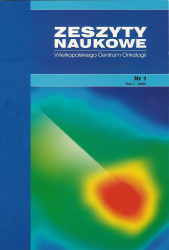Abstrakt
Rak krtani jest jednym z najczęściej wykrywanych nowotworów złośliwych regionu głowy i szyi. Z uwagi na wysoki stopień złośliwości oraz wczesne przerzuty odległe, rak krtani wymaga wczesnej i złożonej diagnostyki. Metodą z wyboru w ocenie guzów regionu głowy i szyi jest badanie pozytonowej tomografii emisyjnej/tomografii komputerowej z użyciem 18F-fluorodeoksyglukozy (18F-FDG PET/CT).
Bibliografia
Majszyk, D., Bruzgielewicz, A., & Osuch-Wójcikiewicz, E. Rak krtani – epidemiologia i etiologia. Polski Przegląd Otorynolaryngologiczny. 2014; 3(4), 186–188.
Kaczmarczyk, D., Bruzgielewicz, A., Osuch-Wójcikiewicz, E. Histopatologia i zmiany przedrakowe w raku krtani. 2014
Tresley, J., Saraf-Lavi, E., Kryvenko, O., Sargi, Z. Epiglottic masses identified on CT imaging: A case report and review of the broad differential diagnosis. The Neuroradiology Journal. 2015; 28(3), 347–353.
Jones, T. M., De, M., Foran, B., Harrington, K., Mortimore, S. Laryngeal cancer: United Kingdom National Multidisciplinary guidelines. The Journal of Laryngology & Otology. 2016; 130(S2), S75–S82.
Sun, C., Han, X., Li, X., Zhang, Y., Du, X. Diagnostic Performance of Narrow Band Imaging for Laryngeal Cancer: A Systematic Review and Meta-analysis. Otolaryngology-Head and Neck Surgery. 2017; 156(4), 589–597.
Agnello, F., Cupido, F., Sparacia, G. i wsp. Computerised tomography and magnetic resonance imaging of laryngeal squamous cell carcinoma: A practical approach. The Neuroradiology Journal. 2017; 30(3), 197–204.
Siddiqui, F., Yao, M. Application of fluorodeoxyglucose positron emission tomography in the management of head and neck cancers, 2014.
Medak, A., Wojtowicz, J., Pietrasz, K. i wsp. The utility of the 18F-FDG PET/CT in the primary and metastatic brain lesions diagnosis. Letters in Oncology Science 2020;17(3):114-118.
Abouzied, M., Fathala, A., Alsugair, A. i wsp. Role of Fluorodeoxyglucose‑Positron Emission Tomography/Computed Tomography in the Evaluation of Head and Neck Carcinoma. 2017; World J Nucl Med. Oct-Dec; 16(4): 257–265.
Zhang, L., Wang, Y., Lei, J., Tian, J., Zhai, Y. Dual time point 18FDG-PET/CT versus single time point 18FDG-PET/CT for the differential diagnosis of pulmonary nodules: a meta-analysis. Acta Radiologica. 2013; 54(7), 770–777.
Kadaria, D., Freire, A. X., SultanAli, I. i wsp. Dual Time Point Positron Emission Tomography/Computed Tomography Scan in Evaluation of Intrathoracic Lesions in an Area Endemic for Histoplasmosis and With High Prevalence of Sarcoidosis. The American Journal of the Medical Sciences. 2013; 346(5), 358–362.
Anderson, C., Chang, T., Graham, M. i wsp. Change of Maximum Standardized Uptake Value Slope in Dynamic Triphasic [18F]-Fluorodeoxyglucose Positron Emission Tomography/Computed Tomography Distinguishes Malignancy From Postradiation Inflammation in Head-and-Neck Squamous Cell Carcinoma: A Prospective Trial. International Journal of Radiation Oncology*Biology*Physics. 2015; 91(3), 472–479.
Ahn SH., Hong HJ., Kwon SY. i wsp. Guidelines for the Surgical Management of Laryngeal Cancer: Korean Society of Thyroid-Head and Neck Surgery. 2017; Clin Exp Otorhinolaryngol; 10:1-43.
Shephard, E. A., Parkinson, M. A., Hamilton, W. T. Recognising laryngeal cancer in primary care: a large case–control study using electronic records. British Journal of General Practice. 2019.

Utwór dostępny jest na licencji Creative Commons Uznanie autorstwa – Bez utworów zależnych 4.0 Międzynarodowe.
Prawa autorskie (c) 2021 Zeszyty Naukowe Wielkopolskiego Centrum Onkologii
